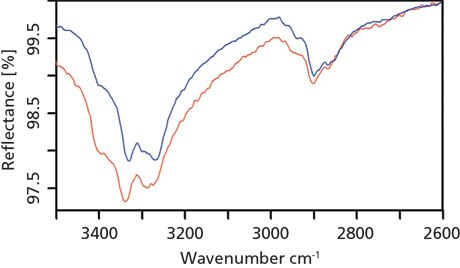Polarization in FTIR ATR
Spectroscopy
For all measurements, a Harrick Wire Grid Polarizer (KRS-5 substrate) was used. The polarizer was oriented in the same position for both background and sample measurements. All spectra were collected using an FT-IR spectrometer at an 8 cm-1 resolution averaged over 32 scans.
Many polymers and thin films on semiconductors are designed with specific molecular orientation to take advantage of mechanical, chemical, or physical properties. Some plastics, for example, exhibit different mechanical strength depending on the orientation. Molecular orientation can be extracted from polarized ATR measurements.
This application note demonstrates determining the correct orientation of the polarizer for these measurements and illustrates the importance of polarized measurements in specific examples.
Experimental
For all measurements, a Harrick Wire Grid Polarizer (KRS-5 substrate) was used. The polarizer was oriented in the same position for both background and sample measurements. All spectra were collected using an FT-IR spectrometer at an 8 cm-1 resolution averaged over 32 scans.
Harrick's Horizon, Seagull, and VariGATR accessories were used here. Such accessories redirect the infrared to and from the sample via mirrors, changing the direction of the electric field which makes it tricky to ascertain the polarizer position for s- or p-polarization. For ATR, the polarizer orientation is straightforward to determine. The effective thickness for p-polarization is nearly twice that for s-polarization at a 45° incident angle (1), which is directly reflected in band intensity.
Three samples were investigated. An unoriented liquid, water, was used to demonstrate the method used to determine polarizer orientation with the Horizontal multiple reflection ATR. Then two oriented samples were examined: Tunicin was measured with the Seagull at a 45° incident angle and an oriented thin film on silicon was examined with the VariGATR at a 65° grazing incidence.
Results and Discussion
Figure 1 shows the ATR spectra of water, measured with the two perpendicular orientations of the polarizer. Clearly, the 0 setting gives bands that are roughly twice as strong as those for the 90 setting, indicating that the former gives p-polarized radiation.

Figure 1: ATR spectra of water recorded with the polarizer set to 90 (red) and 0 (blue).
Figures 2 and 3 show spectroscopic differences resulting from polarized measurements. In Figure 2, the O-H and C-H stretching regions change with polarization, suggesting different orientations of functional groups on the surface. Figure 3 shows differences at 1500 cm-1 and 1250 cm-1. These bands are not visible with s-polarization but are with p-polarization, which probes bonds perpendicular to the interface. This shows the preferential orientation of functional groups on the surface.

Figure 2: ATR spectrum of Tunicin measured with s-polarization (red) and p-polarization (blue).
Conclusion
Combining a polarizer with ATR measurements provides valuable information about the sample, and determining the polarization delivered is straightforward. Polarization can enhance band intensities and provide information on oriented functional groups.

Figure 3: ATR spectrum of a 16 Å thick photoresist ultra-thin film on a silicon wafer, measured with unpolarized (black), s-polarized (red), and p-polarized (blue) incident radiation.
Reference
(1) N.J. Harrick, Internal Reflection Spectroscopy (Wiley, NY, 1967).

Harrick Scientific Products, Inc.
141 Tompkins Ave., 2nd Floor, Pleasantville, NY 10570
tel. (800) 248-3847
Website: www.harricksci.com
